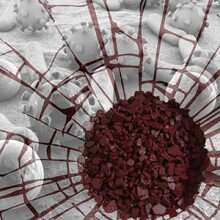Just how resilient are biofilms?

Biofilms hold promise for generating electricity and removing contamination from groundwater, but they also threaten many industrial processes and human health. As the environment changes in which these biofilms thrive, it is unclear how well these living systems will function. Earlier studies proved that certain biofilms were more resilient to changes in their environment, but how they survived was unclear. To help resolve the issue, researchers examined the molecular workings of model biofilms exposed to the toxic chemical, hexavalent chromium. Their work is helping understand biofilms' responses to stress.
Tiny bacteria create a matrix of cells and extracellular polymeric substances that attach to surfaces and build biofilms. Biofilms grow everywhere from the surface of rocks deep underground to the sides of medical devices in hospitals. While biofilms can clog machinery like dam turbines and make some illnesses resistant to medication, these living systems can also be harnessed for good. The key to managing biofilms will be understanding how they function as their environment changes. Armed with this understanding, scientists can encourage growth in useful biofilms and stop growth in harmful ones.
A team of experts from Pacific Northwest National Laboratory, Singapore Centre for Environmental Life Sciences Engineering, Western University of Health Sciences, and EMSL, the Environmental Molecular Sciences Laboratory, set out to discover the inner workings of biofilms, especially when under stress. As shown in the Analyst cover story, "Molecular evidence of a toxic effect on a biofilm and its matrix," a unique microfluidic device allowed the experts to use a vacuum-based scientific instrument, time-of-flight secondary ion mass spectrometry, at EMSL to analyze solid-liquid interfaces in their natural state at the molecular level. Because living systems generally die in a vacuum, this approach opens a new era for studying biofilms in such detail. Images taken with this new capability highlight which component of the biofilms—the bacteria or the extracellular polymeric substances they generate—is responsible for resiliency. The team compared the biofilms' response to exposure to hexavalent chromium between a wild type and a mutant microbe and discovered interesting differences such as a water microenvironment, higher polysaccharide composition, and more active riboflavin in the mutant microbe than the wild type. Their research is improving understanding of how biofilms function.
More information: Yuanzhao Ding et al. Molecular evidence of a toxic effect on a biofilm and its matrix, The Analyst (2019).
Journal information: Analyst
Provided by Environmental Molecular Sciences Laboratory


















